Torbat-e Heydarieh
Persian: تربت حيدريه | |
|---|---|
City | |
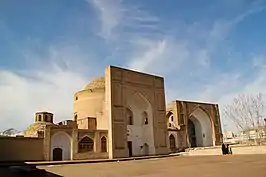    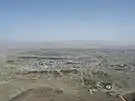 | |
| Nicknames: the Capital of Persian Red Gold or the Capital of Red Gold of Iran or the Saffron City | |
 Torbat-e Heydarieh | |
| Coordinates: 35°17′24″N 59°13′01″E / 35.29000°N 59.21694°E[1] | |
| Country | |
| Province | Razavi Khorasan |
| County | Torbat-e Heydarieh |
| District | Central |
| Population (2016)[2] | |
| • Urban | 140,019 |
| Time zone | UTC+3:30 (IRST) |
| Torbat-e Heydarieh at GEOnet Names Server | |
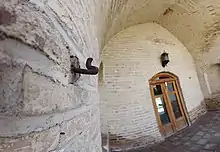
Torbat-e Heydarieh (Persian: تربت حيدريه, also Romanized as Torbat-e Ḩeydarīyeh; also known as Torbat-e Heydari, Turbat-i-Haidari, Torbate Heydari, and Turbet-i-Haidari, and for short Torbat)[3] is a city in the Central District of Torbat-e Heydarieh County, Razavi Khorasan province, Iran, serving as capital of both the county and the district.[4] The closest major city to Torbat is Mashhad and it is 157 Kilometers away.
At the 2006 census, its population was 119,360 in 31,869 households.[5] The following census in 2011 counted 131,150 people in 37,807 households.[6] The latest census in 2016 showed a population of 140,019 people in 43,029 households.[2]
The name Torbat in Persian means Burial place, thus the name of the city means Burial Place of Heydar named after Qutb ad-Dīn Haydar a Sufi mystic whose tomb lies in the heart of the city.
In ancient times this city was known as Zaveh and in the 19th century it was known as Torbat-e Ishaq Khan or Torbat-e Isa Khan after Ishaq Khan Qaraei the powerful chief of the local Qarai Turks who ruled as a semi-autonomous governor of Torbat-e Heydarieh from 1775 to 1816. It derives its present name from the turbet or tomb of a holy man named Kutb ed din Haidar, the founder of the ascetic sect of dervishes known as the Haidaris. He died c. 1230 and is buried in a large domed building a short distance outside the town.[7]
The city is located in the center of Razavi Khorasan province in Iran. This city is famous for its Zafaran (Saffron) fields. Torbat-e Heydarieh is the world's largest Saffron (or Zafaran in Persian) producer hence the nickname "Capital of the Red Gold of Iran" has been given to it.
History
Following the Mongol invasion of Iran,[8] the people of Zaveh (Old Torbat) were the first victims of the Mongol invasion. At the same time, Qutbuddin Haidar, a famous sixth-century mystic who had long resided in the city of Zaveh, died. Torbat-e Heydarieh became a city after the Safavid period.[9] In fact, the city flourished about two hundred years ago, during the reign of Ishaq Khan Qaraei,[10] one of the Khans and political figures of the Qajar era. Ishaq Khan renovated and developed the city and it created such a massive change in the city that this city has become known as Ishaq Khan Torbat for a long time. Prior to World War II, the British and Russian consulates were located in Torbat-e Heydarieh, in the Bagh-e-Soltani area of the city, indicating the city's political and economic importance at the time.
Language and people
The people of Torbat Heydariyeh speak Persian and Khorasani dialect. The dialect of the people of Torbat Heydariyeh is very close to the dialect of other cities of Khorasan, especially the dialect of Mashhad. Books of poems with Torbati accent such as Samandar Khan Salar written by Ali Akbar Abbasi Fahandari and also Torbati shout by Mohammad Ghahraman have been written.[11]
Population
According to the general census of 2016, the population of the city was 140,019 people (in 43,029 households), which in this regard is ranked fourth in the province. The total population of Torbat Heydariyeh County is 224,626 people.[2] Until 1372, the city of Torbat Heydariyeh had the second largest population in the province of Greater Khorasan after Mashhad, which was divided into 5 cities, making its population rank reduced.
Universities and higher education centers
Torbat Heydariyeh in recent years as a university hub in Khorasan Razavi, has good higher education facilities. Torbat Heydariyeh Higher Education Centers are:
Islamic Azad University Torbat Heydarieh[12]
Torbat Heydariyeh University[13]
Torbat Heydariyeh University of Medical Sciences[14]
Mines and industries
Torbat Heydariyeh has two industrial towns and the most important industrial production units of the city include Torbat Heydariyeh Sugar Factory, Zarmehr Gold, Zarrin Tile, Kaolin Factory, also products such as milk and dairies, flour, cumin and cotton gin, animal feed and silk works are also produced in Torbat.[15]
Climate
| Climate data for Torbat-e Heydarieh (1981–2010) | |||||||||||||
|---|---|---|---|---|---|---|---|---|---|---|---|---|---|
| Month | Jan | Feb | Mar | Apr | May | Jun | Jul | Aug | Sep | Oct | Nov | Dec | Year |
| Mean daily maximum °C (°F) | 6.0 (42.8) |
8.2 (46.8) |
13.6 (56.5) |
20.8 (69.4) |
26.3 (79.3) |
31.3 (88.3) |
32.7 (90.9) |
31.8 (89.2) |
28.5 (83.3) |
22.3 (72.1) |
15.3 (59.5) |
8.7 (47.7) |
20.5 (68.8) |
| Mean daily minimum °C (°F) | −4.2 (24.4) |
−2.2 (28.0) |
2.1 (35.8) |
8.1 (46.6) |
12.8 (55.0) |
17.4 (63.3) |
20.0 (68.0) |
18.0 (64.4) |
12.5 (54.5) |
7.0 (44.6) |
2.1 (35.8) |
−2.1 (28.2) |
7.6 (45.7) |
| Average precipitation mm (inches) | 41.0 (1.61) |
48.5 (1.91) |
56.5 (2.22) |
34.6 (1.36) |
18.8 (0.74) |
4.6 (0.18) |
1.1 (0.04) |
0.6 (0.02) |
1.2 (0.05) |
6.1 (0.24) |
13.2 (0.52) |
33.0 (1.30) |
259.2 (10.19) |
| Mean monthly sunshine hours | 177 | 181 | 205 | 248 | 311 | 358 | 377 | 369 | 320 | 285 | 221 | 179 | 3,231 |
| Source: World Meteorological Organization[16] | |||||||||||||
Photo gallery
 Tomb of Qutb ab-Din Haydar
Tomb of Qutb ab-Din Haydar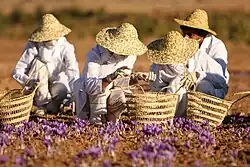
 Altar and roof of Ghotboddin Heydar's Tomb - Photo by Jalal Mirzaei
Altar and roof of Ghotboddin Heydar's Tomb - Photo by Jalal Mirzaei Hesar River in Torbat
Hesar River in Torbat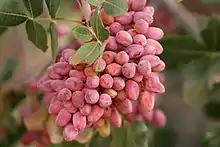
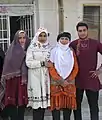 Traditional clothing in Rud Majan of Torbat
Traditional clothing in Rud Majan of Torbat Village of Mahne, Torbat-e Heydarieh County, Mah Welat, Razavi Khorasan Province
Village of Mahne, Torbat-e Heydarieh County, Mah Welat, Razavi Khorasan Province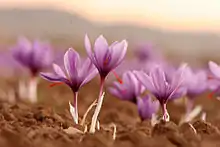 Saffron Farm, Torbat-e-Heydarieh, Razavi Khorasan, Iran
Saffron Farm, Torbat-e-Heydarieh, Razavi Khorasan, Iran Saffron Farm, Torbat-e-Heydarieh, Razavi Khorasan, Iran
Saffron Farm, Torbat-e-Heydarieh, Razavi Khorasan, Iran Saffron Farm, Torbat-e-Heydarieh, Razavi Khorasan, Iran
Saffron Farm, Torbat-e-Heydarieh, Razavi Khorasan, Iran Saffron
Saffron Saffron Farm, Torbat-e-Heydarieh, Razavi Khorasan, Iran
Saffron Farm, Torbat-e-Heydarieh, Razavi Khorasan, Iran Saffron Farm, Torbat-e-Heydarieh, Razavi Khorasan, Iran
Saffron Farm, Torbat-e-Heydarieh, Razavi Khorasan, Iran Saffron Farm, Torbat-e-Heydarieh, Razavi Khorasan, Iran
Saffron Farm, Torbat-e-Heydarieh, Razavi Khorasan, Iran Saffron Farm, Torbat-e-Heydarieh, Razavi Khorasan, Iran
Saffron Farm, Torbat-e-Heydarieh, Razavi Khorasan, Iran Saffron Farm, Torbat-e-Heydarieh, Razavi Khorasan, Iran
Saffron Farm, Torbat-e-Heydarieh, Razavi Khorasan, Iran Saffron Farm, Torbat-e-Heydarieh, Razavi Khorasan, Iran
Saffron Farm, Torbat-e-Heydarieh, Razavi Khorasan, Iran Saffron Farm, Torbat-e-Heydarieh, Razavi Khorasan, Iran
Saffron Farm, Torbat-e-Heydarieh, Razavi Khorasan, Iran Pistachio farm, Torbat-e-Heydarieh, Razavi Khorasan, Iran
Pistachio farm, Torbat-e-Heydarieh, Razavi Khorasan, Iran Dried pistachios, Iran
Dried pistachios, Iran
Notable people
- Mahmoud Shehabi Khorassani, born 1903 in Torbat-e Heydarieh, died in 1986 in Mulhouse, France; a lawyer, a high-ranking philosopher and one of the most famous and eminent jurists of the Pahlavi era. He was a distinguished and emeritus professor at the University of Tehran
- Laleh Eskandari, born 1975 in Torbat-e Heydarieh; an Iranian actress
- Reza Rafi, born August 1968 in Torbat-e Heydarieh; an Iranian writer, satirist, journalist, and showman
- Saeed Soheili, born 1959 in Torbat-e Heydarieh; an Iranian director and script writer
- Setareh Eskandari, born 15 June 1974 in Torbat-e Heydarieh; an Iranian actress
References
- ↑ OpenStreetMap contributors (9 May 2023). "Torbat-e Heydarieh, Torbat-e Heydarieh County" (Map). OpenStreetMap. Retrieved 9 May 2023.
- 1 2 3 "Census of the Islamic Republic of Iran, 1395 (2016)". AMAR (in Persian). The Statistical Center of Iran. p. 09. Archived from the original (Excel) on 2 April 2022. Retrieved 19 December 2022.
- ↑ Torbat-e Heydarieh can be found at GEOnet Names Server, at this link, by opening the Advanced Search box, entering "-3087658" in the "Unique Feature Id" form, and clicking on "Search Database".
- ↑ Habibi, Hassan (21 June 1369). "Approval of the organization and chain of citizenship of the elements and units of the divisions of Khorasan province, centered in Mashhad". Lamtakam (in Persian). Ministry of Interior, Defense Political Commission of the Government Council. Archived from the original on 27 December 2023. Retrieved 27 December 2023.
- ↑ "Census of the Islamic Republic of Iran, 1385 (2006)". AMAR (in Persian). The Statistical Center of Iran. p. 09. Archived from the original (Excel) on 20 September 2011. Retrieved 25 September 2022.
- ↑ "Census of the Islamic Republic of Iran, 1390 (2011)". Syracuse University (in Persian). The Statistical Center of Iran. p. 09. Archived from the original (Excel) on 20 January 2023. Retrieved 19 December 2022.
- ↑ One or more of the preceding sentences incorporates text from a publication now in the public domain: Chisholm, Hugh, ed. (1911). "Turbet i Haidari". Encyclopædia Britannica. Vol. 27 (11th ed.). Cambridge University Press. p. 411.
- ↑ "The Mongol Invasion of Eastern Persia 1220-1223 | History Today". www.historytoday.com. Retrieved 5 January 2022.
- ↑ "History of Iran: Safavid Empire 1502 - 1736". www.iranchamber.com. Retrieved 5 January 2022.
- ↑ "شهرداری تربت حیدریه - شهرداری تربت حیدریه". 10 December 2018. Archived from the original on 10 December 2018. Retrieved 5 January 2022.
- ↑ "You are being redirected..." www.ettelaat.com. Retrieved 19 January 2022.
- ↑ "Islamic Azad University Torbat e Heydarieh - | Admission | Tuition | University". www.unipage.net. Retrieved 15 May 2022.
- ↑ niafam.com. "University of Torbat-e Heydarieh (UTH)". opatel.tums.ac.ir. Retrieved 15 May 2022.
- ↑ "Torbat Heydarieh University of Medical Sciences".
- ↑ "User contributions for Hogo-2020 - Wikipedia". en.wikipedia.org. Retrieved 9 March 2022.
- ↑ "World Meteorological Organization Climate Normals for 1981–2010". World Meteorological Organization. Retrieved 6 October 2022.
Sources
- Tarikh-e Torbat-e Heydarieh: ba tekiye be naqshe Ishaq Khan Qaraei, Mohammad Qaneyi
- Chisholm, Hugh, ed. (1911). . Encyclopædia Britannica. Vol. 27 (11th ed.). Cambridge University Press.
